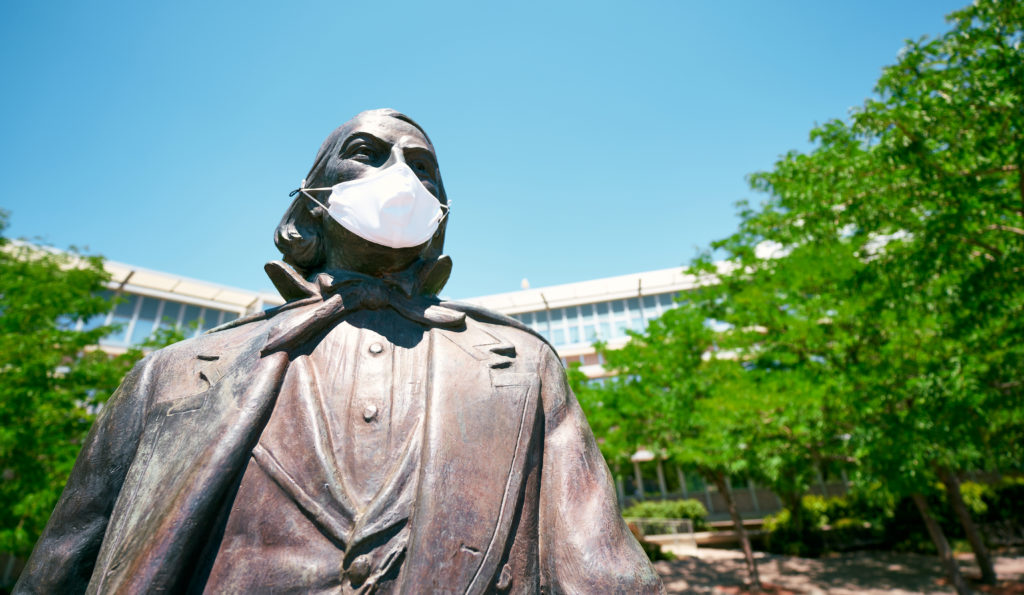
There was a lot of anxiety and unanswered questions regarding COVID-19 heading into Fall Semester. “Would campus stay open more than a week or two?” “What would thousands of returning students mean for Utah’s COVID-19 cases?”
As the old adage goes, hindsight is 20-20. So how did BYU actually fare this semester in terms of COVID-19?
“There’s some good news, and there’s some bad news,” said Chantel Sloan, a BYU public health professor who played an active role in projecting what BYU’s Fall Semester would look like with COVID-19.
“The bad news, of course, is that we saw a huge spike in transmission, as expected, within the first three weeks of the semester,” she said.
BYU professor Ben Abbott, who studied the effectiveness of masks during the pandemic with students and other BYU researchers, said he believes the university was on track to close during those first few weeks.
The turning point, he said, was a joint letter issued by BYU and UVU warning students to adhere to COVID-19 safety guidelines, especially off campus.
“BYU did much better than expected based on what we understood of the disease at the beginning of the semester,” Abbott. “I think on the whole it’s a success story.”
That was only made possible by careful and intentional precautions that were made, he added. BYU spokesperson Natalie Ipson agrees. “Those declines in the cases are real, and the decline is not a result of a decrease in testing or a decrease in receiving reported test results,” she said.
Another bright side of the BYU community’s interaction with the pandemic, according to Sloan, is that few students have needed intensive medical attention due to COVID-19. “That’s been better than I expected,” she said.
That’s likely due to a few reasons: vulnerable students have chosen to do remote classes, some of the treatments for the disease have improved and regulations around when someone is hospitalized have changed.
“Now that’s not to say that student illness hasn’t been serious,” she said, explaining that some students have had very intense symptoms or long-term complications.
Lessons learned
Fall Semester proved what most experts were saying about the virus before universities opened back up, namely that student housing is a hotspot for infections and college outbreaks can lead to infections and deaths among more vulnerable populations.
The Chronicle of Higher Education reported that two of the top takeaways from the past few months are that off-campus social gatherings are the top drivers of COVID-19 cases at colleges and that testing students right before they arrive on campus and conducting asymptomatic testing throughout the term “is necessary to identify and deal with outbreaks before they careen out of control.”
Utah appears to be taking the second lesson to heart. Most of the state’s universities are already complying with a public health order mandating testing of college students at least every 14 days by January. BYU increased asymptomatic testing before Thanksgiving break and will continue to do so next semester.
Sloan said BYU has also seen very few cases of classroom transmission. However, transmission has been high in housing as well as at small gatherings and social events.
“So that’s the biggest challenge I think going into Winter Semester, is how do we prevent that from happening again,” Sloan said. “If we go forward and repeat the same things that we did last semester, we’re going to have the same outcome. It’s not a question of if anymore because we’ve seen it.”
Other lessons have come from outside of Utah, such as social bubbles. In places like the UK, social bubbles have been used to balance individuals’ need for human connection with safety guidelines. A bubble consists of a few households that are able to interact normally around each other. Outside of that group the bubble members wear masks and practice social distancing.
“It would take a lot of commitment from the campus community to make that happen,” Sloan said. “That would be that would reduce spread, along with more testing, more than anything else I can think of.”
Winter Semester
BYU’s Winter Semester is currently four weeks away. At this point before Fall Semester, Utah reported just 354 new cases, a seven-day average of 435, a positivity rate of 9.8% and 207 hospitalizations on Aug. 3.
Those are minor numbers compared to the 1,968 new cases the state reported today. Utah also currently has a seven-day average of 2,598, a 24% positivity rate and 572 hospitalizations.
In other words, things are looking a lot more dire than they did before Fall Semester — and they may get even worse before January due to holiday travel.
“It is a major concern,” Sloan said. “BYU is starting classes a little bit late in Winter Semester, but honestly, they’re gonna be bringing a lot of people back into what’s already a bad situation.”
It’s likely that, just like Fall Semester, Winter Semester will bring another peak of cases among the BYU community, said Sloan.
Another factor working against BYU next semester is the fact that cold weather will drive more individuals indoors. “There’s a risk that if we let our guard down, that there could be very rapid spread early on in the semester and that’s really hard to recover from,” Abbott said. “I don’t think any of us should assume that we’re going to make it through automatically.”




